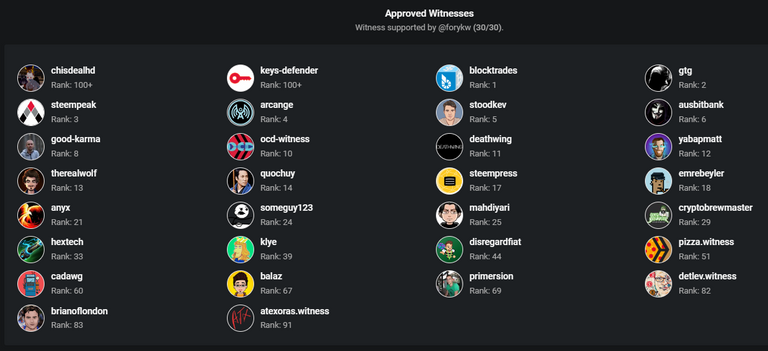and you will notice that after 150 places or so, it's very rare for a backup witness to produce a block.
Thanks so much for the information :)
Considering that I don't run a project or anything, my guess is that I would place very low. How much Hive is needed to run a node, and can it be powered up while going towards the node?
!ALIVE
You Are Alive so I just staked 0.1 $ALIVE(9/10)@forykw! to your account on behalf of @wrestlingdesires.
The tip has been paid for by the We Are Alive Tribe
 through the earnings on @alive.chat, feel free to swing by our daily chat any time you want.
through the earnings on @alive.chat, feel free to swing by our daily chat any time you want.
The placing is irrelevant to that, to be honest. People need to know what you are doing, be capable of offering to the community and be able to protect. There is a multitude of reasons, to be honest. But the easiest one might be, you aren't doing anything wrong and running a node for a very long time (which by definition you would be helping the network in the long term...). But this is by no means the "best standard" (probably not even 1% close... but serves as a simple basic explanation).
To run a node all you need is memory, CPU, internet and disk to hold the blockchain (preferably SSD or better). No need for staking because of the way HIVE works. This means that the only "power up" you can do is use your own account and then vote for yourself.
Example of the witnesses I am voting for at the moment:

The HIVE power of each voter will contribute to that voted witness to raise on the list, and then the higher the witness is, the closer it gets to the top20, etc...
You are currently proxying through someone else, which means that someone will decide the votes, not you. All the powered-up HIVE you have is being used to vote on the proxy you have chosen. There is nothing wrong with that if you control that proxy... for example. Otherwise, you need to be sure you trust the voting of that other account. This can be changed at any time.
To set up a witness node just for verifying blocks does not require you to open it to the public. Similar to not specifying the "seed" option on most of the "master nodes" wallets (if you are familiar). The node will just connect to other peers and not allow/expect to receive connections from other nodes in order to exchange blocks/transactions.
What kind of CPU power is necessary to run a node? Do most datacenters frown upon it like they do mining?
I know, I set that up when I first decided to consider Hive my new and permanent home (long story). It was explained how important voting was, but I only knew of one witness at that time, so I put the person who taught me how to blog properly as a proxy. Now that I know more people, I really should do my own voting. How many witnesses can we vote for?
Thanks so much for explaining all this, by the way 🙌
!PIZZA
Considering only a simple witness type of node, CPU, very little (in the sense to run). But to perform some of the other admin tasks, such as synchronize and if it has too many requests... things can get to the order of some (6 or more) CPU cores... but for any local thing, any recent CPU with 4 cores is more than enough. During the synchronization, it is when the technology (recent) will matter most.
Yes, some datacenters have become restrictive to "mining"... and also confused others... making this a much greater pain.
Memory wise it's more demanding... at least 24 GB will be required. I would recommend 32 GB for starters... and this is a node that does not include the former "history" of the blockchain... Just a simple verification witness node...
On the memory side, something called "shared_memory.bin" (memory mapped file) needs to be residing in memory (because otherwise will be too slow), the memory requirements are mostly to hold the size of this file... which changes slightly depending on the plugins activated. For a witness node, it goes around 20GB at the moment (for me)... but it can change.
Then disk... you will need around 500 GB at least for holding things for at least the next year I would say. The best will be to get a 1TB NVMe... they are not that expensive anymore, and they suck up IOps like a real mustang. Which speeds up things a lot.
30 and if one does not vote for 1 or more years, the vote will decay (cease to have power). So this is actually a protection that allows the "big attacking" players to not be able to "set and forget". A chain can only be secure if the current security is "up to date".
It's the reason I like to be around. To explain what I can... capture great opportunities that would help decentralization, and have some fun (when possible)!
I'll have to check if mine allows it :) ... The chance of producing a block now and then wouldn't hurt.
!LUV
(1/10) sent you LUV. | tools | discord | community | HiveWiki | NFT | <>< daily
NFT | <>< daily